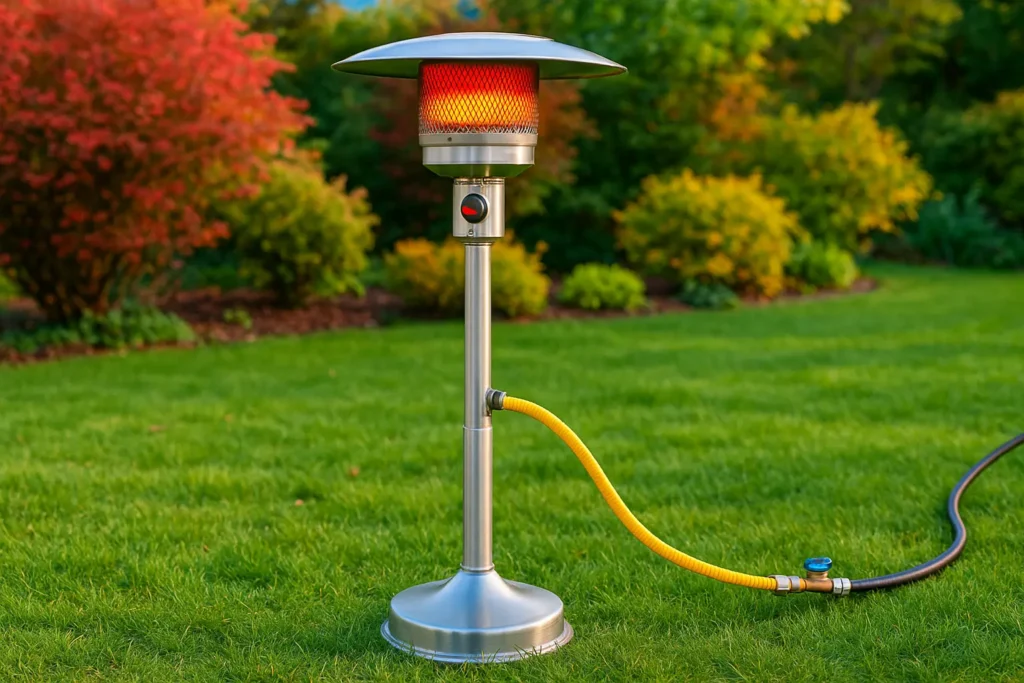Introduction
When the evenings grow cooler, a natural gas outdoor heater can turn your patio into a warm, inviting space for family dinners, weekend barbecues, or simply relaxing under the stars. But with so many options out there, finding the right heater can be a little overwhelming. This guide will walk you through everything you need to know—whether you’re looking for the best natural gas patio heater for a large outdoor area or a wall-mounted unit for your alfresco space. We’ll help you choose based on your lifestyle, space, safety, and energy efficiency needs.
Outdoor Natural Gas Heater Buying Guide
Natural gas outdoor heaters are popular for a good reason. They tend to have lower running costs than electric or propane options, meaning you’ll save money in the long run—especially if you use your outdoor space frequently. One of their best perks is the continuous gas supply, so there’s no need to replace tanks or worry about running out mid-party. Plus, natural gas heaters usually provide a higher heat output, delivering better warmth coverage for larger spaces. They’re also considered more eco-friendly, emitting fewer pollutants than some propane outdoor heaters or wood-burning options. All of these benefits make them a smart and sustainable choice for home heating.
Assessing Your Outdoor Space
Before choosing a heater, it’s important to evaluate your space. The size of the area will determine how powerful your heater needs to be. For instance, a small balcony might only need 20,000 BTU, while a spacious deck could require up to 50,000 BTU. Also, consider how wind exposure might affect heat dispersion—open, breezy areas will lose warmth faster, so placing your heater near walls or using windbreaks can help. If your patio is covered, it will retain heat better, but make sure there’s adequate ventilation for safety. Since most natural gas heaters are fixed installations, you’ll need to plan ahead whether it’s wall-mounted or ceiling-mounted, as portability isn’t an option like it is with propane models.
Can You Use Gas Heater on Balcony Australia
Yes — in many cases you can use a gas heater on a balcony in Australia, but only if it meets ventilation and safety requirements. According to Australian gas safety guidelines, a balcony is considered an outdoor space if at least 20–25% of its wall area is permanently open and unobstructed, allowing combustion gases to disperse naturally. This means enclosed balconies with glass panels, louvres, or heavy weather screens may not be suitable. You’ll also need to check your strata or building by‑laws, as some complexes restrict gas appliances due to fire risk or insurance conditions.
If your balcony qualifies as an open‑air space, choose a balcony‑safe outdoor gas heater with built‑in safety features like a Flame Failure Device (FFD) and tilt switch. Position it away from combustible materials, and ensure the manufacturer’s instructions specifically allow balcony use. For apartments, a wall‑mounted or ceiling‑mounted natural gas heater connected via a bayonet fitting is often the safest and most space‑efficient choice.
Key Technical Features to Consider
| Feature | What to Look For |
|---|---|
| BTU Rating | 30,000–50,000 BTU for medium to large patios |
| Ignition Type | Electronic ignition is more reliable than manual ignition |
| Build Material | Stainless steel resists rust and outdoor wear |
| Heating Radius | Check product specs; usually 10–20 feet |
| Safety Shut-Off Valve | Essential for safe operation |
| Thermostat Control | Optional but useful for consistent temperature management |
| Mounting Type | Wall-mounted, ceiling-mounted, or freestanding |
Gas Heater Installation
Installing a natural gas outdoor heater isn’t a DIY task. These units need to be professionally installed and connected to your home’s gas line, which must be done by a licensed gas fitter or plumber. Depending on your location (especially in Australia), there may be permit requirements you’ll need to meet. It’s also important to ensure the heater’s gas pressure matches your home’s supply—most models require around 7–10 inches of water column pressure. Be sure to review clearance guidelines as well; ceiling or wall-mounted units require minimum distances from flammable surfaces to prevent fire hazards. Planning the installation carefully will not only keep things safe but also ensure your heater works efficiently from day one.
Natural Gas Bayonet Installation Cost Sydney
In Sydney, installing a natural gas bayonet fitting — the quick‑connect point for your outdoor heater — typically costs between $300 and $600 for a straightforward job. This price includes labour, materials, and a Certificate of Compliance, which is essential for insurance and legal purposes. Costs can rise if extra pipework is needed, if the fitting is in a difficult‑to‑access location, or if you’re adding multiple outlets.
Only NSW‑licensed gas fitters can legally install bayonet fittings, and they must follow AS/NZS 5601 standards. The bayonet point should be at least one metre from doorways and away from bedrooms or bathrooms. For outdoor heaters, fittings are often installed on an exterior wall near the heater’s mounting location, making it easy to connect and disconnect as needed.
Safety Features and Certifications
Safety should always be top of mind when choosing an outdoor heater. Look for models with a Flame Failure Device (FFD), which automatically cuts off the gas if the flame goes out—an essential feature for preventing gas leaks. If you’re using a freestanding model, tilt switches are a great safety bonus, as they shut the unit off if it gets knocked over. Always choose heaters that have safety certifications, like CSA or AGA, to ensure they meet Australian or North American safety standards. Remember, these heaters are designed for outdoor use only, so they’re not suitable for enclosed patios, garages, or indoor spaces, even if they’re ventilated.
Clearance Distances Outdoor Gas Heater
Every outdoor gas heater has specific clearance distance requirements to prevent fire hazards and ensure proper airflow. For most natural gas wall‑mounted or ceiling‑mounted units, you’ll need at least 900 mm to 1.5 m from the ceiling and at least 1 m from side walls or combustible materials. Some models allow reduced ceiling clearance (down to 350 mm) if a heat deflector is installed above the heater head.
Clearances aren’t just about fire safety — they also affect performance. If a heater is mounted too close to a ceiling or wall, heat can be trapped and wasted, while too much distance can reduce warmth in your target area. Always follow the manufacturer’s diagrams, and remember that covered patios and semi‑enclosed spaces must still have adequate ventilation — at least 25% open area for gas heaters.
Energy Efficiency and Long-Term Costs
Natural gas heaters are well-known for their energy efficiency. While the initial setup may cost more, they offer lower operational costs over time, especially when compared to electric heaters. To understand your future expenses, calculate the BTU/hr of the model and convert it into cubic meters of gas to estimate fuel usage. If energy savings are a priority, look for models with a thermal efficiency rating of 80% or higher. These models will convert most of the gas into usable heat instead of wasting it. All in all, if you’re using your heater regularly, a natural gas model can provide significant savings.
Maintenance Outdoor Gas Heater
To keep your heater in top shape, you’ll need to perform some regular maintenance. For starters, clean the burner ports occasionally to prevent blockages from dust or insects. Inspect gas lines annually for signs of corrosion or leaks, especially before each winter season. If your unit uses batteries or an electric igniter, expect to replace those parts every few years. Protect your investment by covering your heater when it’s not in use or during long periods of rain. With proper care, a high-quality natural gas heater can last 10 years or more, making it a great long-term addition to your outdoor space.
Troubleshooting Outdoor Gas Heater
Even the best outdoor gas heaters can develop issues over time, but most problems have simple fixes. If your heater won’t ignite, check that your gas supply is on, the bayonet connection is secure, and the ignition system is sparking. For low heat output, inspect the burner ports for blockages from dust, insects, or spider webs — a common cause of poor performance.
If the pilot light won’t stay lit, the thermocouple may be faulty or dirty. Cleaning it with fine sandpaper or replacing it can restore normal operation. Also, check the bug screen and air inlets for obstructions, as restricted airflow can smother the flame. For persistent issues, or if you smell gas, stop using the heater immediately and call a licensed gas fitter for inspection. Regular seasonal servicing can prevent most of these problems before they start.
Top Brands and Product Recommendations
| Brand | Notable Model | BTU Output | Special Feature |
|---|---|---|---|
| Bromic | Tungsten Smart-Heat | 43,000 BTU | Smart control compatible |
| Dyna-Glo | Premium Wall Heater | 30,000 BTU | Thermostat and dual fuel options |
| Mr. Heater | Big Maxx NG Garage Heater | 50,000 BTU | Great for covered outdoor garages |
| Heatstrip | Classic THH Series | 40,000 BTU | Sleek design, made for Australian homes |
Frequently Asked Questions
Only if your building permits it and there’s enough ventilation. Check strata rules first.
Yes, but make sure you follow minimum clearance requirements and maintain good airflow.
Professional installation typically ranges from $300–$800 AUD depending on your gas line setup.
Some models can be converted using certified kits, but this should only be done by a licensed technician.
You’ll need a heater with at least 30,000–40,000 BTUs depending on how exposed the space is.
Final Thoughts
Choosing the best natural gas outdoor heater doesn’t have to be complicated. Start by understanding your space and heating needs, then focus on key technical features, safety certifications, and professional installation. With the right unit, you’ll enjoy efficient, reliable heat that transforms your patio into a year-round retreat. Whether you want a modern ceiling-mounted heater or a heavy-duty wall unit, there’s a perfect match out there—just make sure it’s safe, certified, and built to last.

